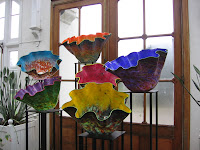I passed my 3rd year (diploma) in Fine Art at NMMU and was allowed to start my Btech degree: all focus on the glass work and a dissertation to write about it.
The most difficult point was determining an overall topic, that could be explored and developed into a portfolio of work. The process to reveal underlying thoughts and sources of interest and inspiration was a revelation in itself and I sincerely enjoyed digging deeper into my inner person. Seeing that a great part of my life I have worked with words, letters and text I eventually chose that as foundation for my Btech work. I was greatly inspired by
Willem Boshoff, who creates installations based on many aspects of language and usage of words.
Most of the other students decided on a theme and all the work for that year was either one elaborate, complex piece or a series of variations on the same theme. Early on I decided that – because I still wanted to keep experimenting with various techniques – I wanted to apply these techniques in various, but totally independent works.
These were the projects that I planned:
"A Touching story": a Braille project : the tactile format of reading and communication
"Palimpsest": a historical project: with reference to bygone era’s and old parchments
"Ambigrams": a fun project: small glass jewellery with decorative word designs
"Food for thought" : the wisdom of words and a connection between food and the mental state of the human being.
"A Touching Story"
Recalling the phase of experimenting with slumping glass in the previous year, I realised that the texture of slumped glass was very tactile and my thought process brought me to the world of Braille where the understanding of language is totally by touch and feel. I communicated with the local blind association for advice regarding the best suited text for the project. I decided on:
“ There is a wonder about reading Braille that the sighted will never know: to touch words and have them touch you back”by Jim Fiebig.


I made it into a 4 part wall installation with the complete text sandblasted (for the sighted), the same text in Braille (slumped panels), and a decorative acid etch graphic lay out with the main key words: “wonder of touching words”. I eventually installed it at the local Blind association as a gift.
"Palimpsest"
Palimpsest = old parchment that has been rubbed out and cleaned, ready for the next text to be written, but shadows linger from the previous text.
This was a beautiful project to focus on a church ruins in our town and the history it entailed. I decided to make it into a light column as a allusion of the church as a beacon for the community. Silver stains and oxides gave the glass its brown weathered look. The elements on the pillar were a combination of historical remnants of the building, reference to its name and the connection to bible text and symbology. Some parts were separately fused pieces, that were attached with uv glue.

"Ambigrams"
The fun jewellery was inspired by a fascination of the graphic design aspect of ambigrams: is a graphical rendering that spells out one or more words not only in its form as presented, but also in another direction or orientation. Even though, in the end, this project had the least satisfying final result, the design of the words was great fun.
"Food for thought"
I wanted to make bowls with quotes / text but the particular texts needed to make a link between food (the bowls) and words (as the subject matter and in a deeper sense referring to the human ability to think and experience). Living in the Eastern Cape I also decided that I wanted to make one in each of the 3 official languages of this area: English, Afrikaans and Xhosa.



- English: Born and bred in the Eastern Cape, it was only fitting to use a quote of Nelson Mandela referring to the mental as well as the physical needs and rights of the people.
Afrikaans: an exerpt of a poem of renowned Afrikaans poet Elizabeth Eybers. She was the first Afrikaans poet I read and I used passages of various of her poems on the birth announcements of my three children.
Xhosa is the most prominent indigenous language in the Eastern Cape and the proverb makes the comparison between an unexpressed mind and the inability to judge the inside of a fruit, just by looking at it.
I truly enjoyed this project and on the spur of the moment decided to expand the bowl series and made another few. While the first 3 were a combination of fusing, slumping, a detail painted in oxides, acid etching and sandblast, the expanded series was only done with acid etch and sandblasting onto a slumped bowl.



I enjoyed this year and learned not only about various techniques, but also about thinking and finding deeper meaning for what I can do with glass.



























